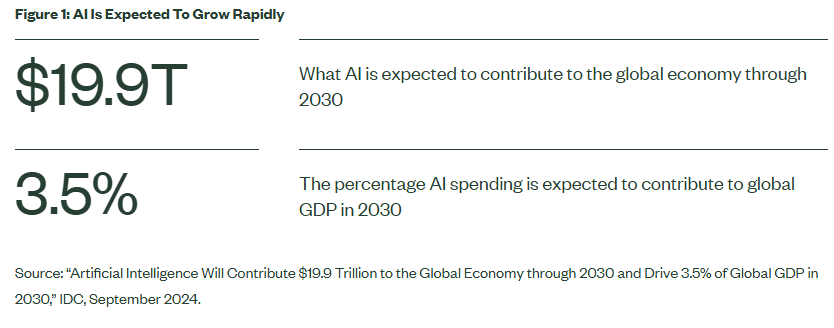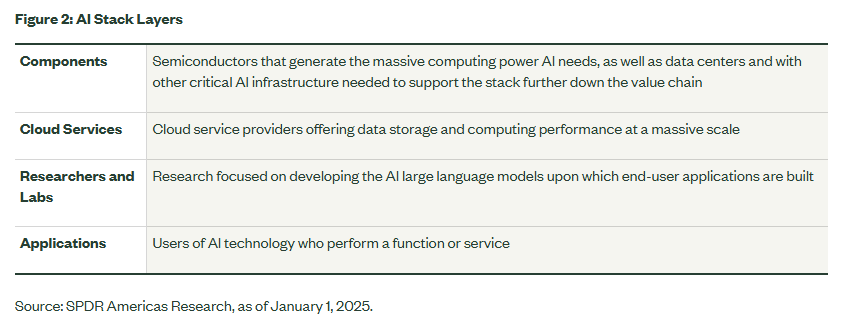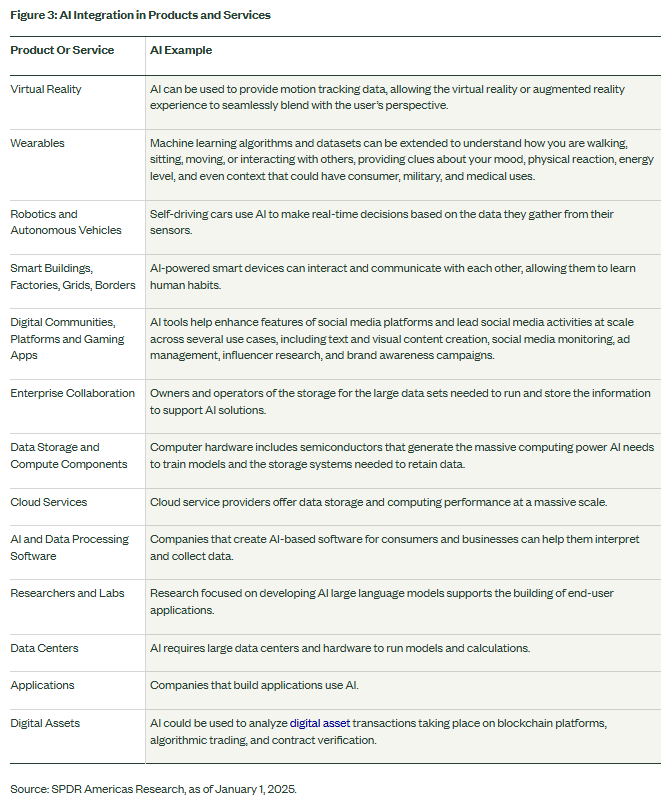By: Matthew J Cartolini
- Artificial Intelligence (AI) is driving headlines, but it’s difficult to define AI or capture its full potential in a single investment exposure.
- More than a chatbot, AI is supported and used by advanced technologies like semiconductors, cloud computing, and autonomous vehicles.
- As AI evolves and its reach expands, investors may want to take a broader view and pursue more diverse AI exposures.
The other day I asked Alexa, “What’s AI?” The response:
“I found this on Wikipedia: AI is intelligence — perceiving, synthesizing, and inferring information — demonstrated by machines, as opposed to intelligence displayed by humans or by other animals. Intelligence encompasses the ability to learn and to reason, to generalize, and to infer meaning.”
Of course, Alexa also could have just as easily said, “I am.” But defining AI as a consumer-facing device used to play music and report the weather would be far too limiting, given how entrenched and intertwined AI is with so many parts of our economy.
AI Is a Force for Transformation, Not a Sector
It’s helpful for investors to think of AI not as a sector or industry, but rather a key catalyst of transformational changes impacting our society.
Alongside hyper-connectivity, supercomputing, and biological innovation, AI is a technological pillar that allows economies to create more value with less inputs to propel economic growth. In fact, International Data Corporation predicts that business spending to adopt AI, to use AI in existing business operations, and to deliver better products/services will have a cumulative global economic impact of $19.9 trillion through 2030 – driving 3.5% of global GDP in 2030.1

From LLMs to the AI Stack
AI is more than large language models (LLMs) like ChatGPT — it’s a transformational technology supported and used by other advanced technologies, from semiconductors and cloud computing to medical devices and autonomous vehicles. As a productivity tool that fuels innovation, AI requires advanced inputs. And AI’s entire ecosystem can be broken down into mutually reinforcing functions and technologies as part of a broader AI stack — or an AI value chain with building blocks stacked atop one another.
What’s referred to as the “AI stack” encompasses all the technologies and functions that enable AI layers. The different layers of the AI stack — infrastructure, model, and application — include specialized software, hardware, and services that make the AI engine run.

How to Invest in AI: Diversify Across the AI Stack
Viewed broadly, AI is a change agent. And so, the question investors should be asking is, “Which companies are likely to benefit from this change agent?”
To pursue the full value of AI, you may want to take a more inclusive view of its potential impacts across various sectors, industries, and companies. Rather than seek out pure AI investment exposures, it may be more beneficial to own the AI ecosystem — both the building blocks underpinning AI’s development, like computer hardware, and the companies rapidly adopting AI to drive the broader technological innovations like autonomous vehicles (Figure 3).

Pinpointing pure AI investment exposures, as desirable as that may sound, is challenging and, even if pure exposures do exist, they may not fully capture AI’s potential. Consider casting a wider net by focusing on the entire AI stack.
Avoiding AI FOMO When the Headlines Hit
AI is an exciting headline trend for many investors. While the buzz is real and hard to ignore, the truth is that AI’s full economic impact remains a futuristic forecast for now.
As AI continues to evolve, economists and consultants will continue to debate the magnitude of its growth and macroeconomic impacts. But the possibilities for how AI may fuel those gains are increasing, as the AI stack expands to include more enablers and potential beneficiaries.
By investing in the full AI stack, you may be able to better capture the full potential of AI as a transformational driver of growth across a broad range of sectors and industries.
Originally posted on January 24, 2025 on SSGA blog
PHOTO CREDIT: https://www.shutterstock.com/g/micic
VIA SHUTTERSTOCK
FOOTNOTES AND SOURCES:
1 “Artificial Intelligence Will Contribute $19.9 Trillion to the Global Economy through 2030 and Drive 3.5% of Global GDP in 2030,” IDC, September 2024.
DISCLOSURES:
Investing involves risk including the risk of loss of principal.
The whole or any part of this work may not be reproduced, copied or transmitted or any of its contents disclosed to third parties without SSGA’s express written consent.
All information is from SSGA unless otherwise noted and has been obtained from sources believed to be reliable, but its accuracy is not guaranteed. There is no representation or warranty as to the current accuracy, reliability or completeness of, nor liability for, decisions based on such information and it should not be relied on as such.
The information provided does not constitute investment advice and it should not be relied on as such. It should not be considered a solicitation to buy or an offer to sell a security. It does not take into account any investor’s particular investment objectives, strategies, tax status or investment horizon. You should consult your tax and financial advisor.
This communication is not intended to be an investment recommendation or investment advice and should not be relied upon as such.
This document contains certain statements that may be deemed forward-looking statements. Please note that any such statements are not guarantees of any future performance and actual results or developments may differ materially from those projected.
The views expressed in this material are the views of the SPDR Research and Strategy team through the period ended January 1, 2025, and are subject to change based on market and other conditions. It should not be considered a solicitation to buy or an offer to sell any security. It does not take into account any investor’s particular investment objectives, strategies, tax status or investment horizon. There is no representation or warranty as to the current accuracy of such information, nor liability for decisions based on such information. Past performance is not a reliable indicator of future performance.
Technology companies, including cyber security companies, can be significantly affected by obsolescence of existing technology, limited product lines, and competition for financial resources, qualified personnel, new market entrants or impairment of patent and intellectual property rights that can adversely affect profit margins.
Narrowly focused investments and investments in technology stocks may involve greater risk of capital loss and higher price volatility.
Because of their narrow focus, sector investing tends to be more volatile than investments that diversify across many sectors and companies.
Equity securities may fluctuate in value and can decline significantly in response to the activities of individual companies and general market and economic conditions.
